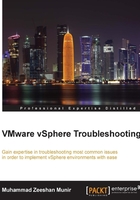
Chapter 2. Monitoring and Troubleshooting Host and VM Performance
In the previous chapter, you learned some basic troubleshooting skills and performed some vSphere troubleshooting. This chapter extends those skills deeper by using different monitoring tools to observe vSphere performance and identifies any potential problems that can cause bottlenecks in your infrastructure.
The topics covered in this chapter are as follows:
- Tools for performance monitoring
- Analyzing the esxtop results
- Understanding key performance metrics (CPU, memory, network, storage)
- Using vMA and remote esxtop
- Analyzing vCenter performance charts
- Creating charts
- Configuring metrics
- Configuring logging level for performance
- USB attached virtual machines
- Fault-tolerant virtual machines
The previous chapter thoroughly covered how to collect diagnostic information and different logs from vSphere hosts. Sometimes, the diagnostic information you have collected is not enough to identify the root cause of the problems vSphere hosts are having. In order to investigate such problems further, you are required to use different performance monitoring tools. These tools will help you to collect additional data, which could further help you to identify the root cause and would make analyzing the collected data easier.